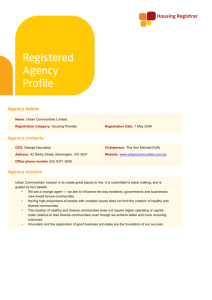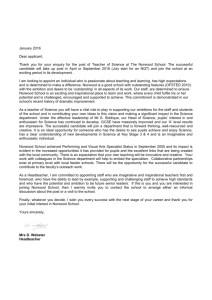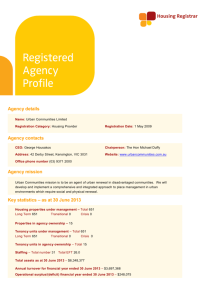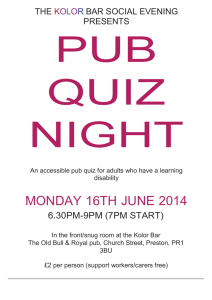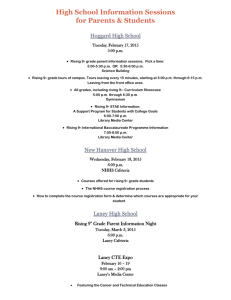- Flinders University
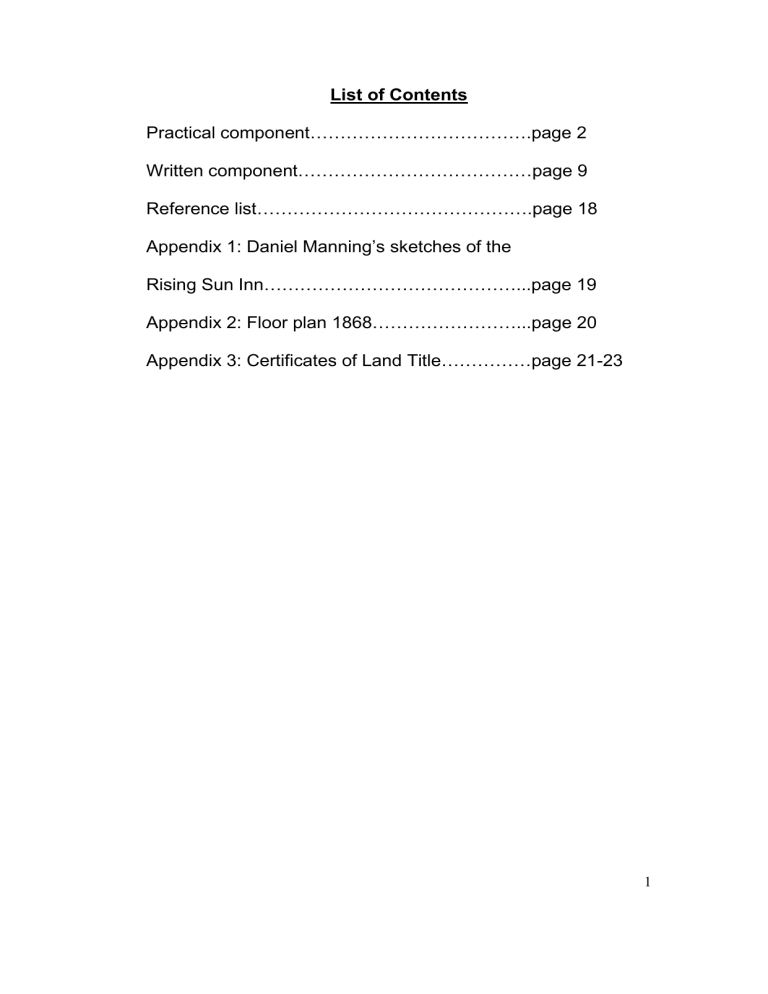
List of Contents
Practical component……………………………….page 2
Written component…………………………………page 9
Reference list……………………………………….page 18
Appendix 1: Daniel Manning’s sketches of the
Rising Sun Inn……………………………………...page 19
Appendix 2: Floor plan 1868……………………...page 20
Appendix 3: Certificates of Land Title……………page 21-23
1
Practical component
My interest in the history of the Rising Sun Inn in Kensington stems from a time when I was residing in the local area, and became a patron of the establishment. Several plaques that hung in the front bar area of the pub told of its establishment in 1848, its first owner William Beck, and of its subsequent closure and reopening. These plaques served as a useful starting point for my future research, as they provided a broad outline of the pub’s history, as well as an opportunity to familiarise myself with certain names and events that would figure prominently throughout my research.
Despite having read the plaques in the Rising Sun, I was initially in some confusion as to the whereabouts of the original structure, as the name
‘Rising Sun’ had been applied to both the current hotel on Bridge Street, and a structure further down the road, on the corner of Bridge and High
Streets. I suspected that the current hotel was also the site of the original pub, but in order to shed light on this, I located two useful secondary sources that helped to clarify this point. These sources, which I located in the Flinders University Library, were both histories of Kensington and
Norwood, compiled by local historians for the council on the fiftieth and hundredth anniversaries respectively of the townships. These histories,
Fifty Years’ History of Kensington and Norwood ( 1903 ) and The Hundred
Years History of Kensington and Norwood ( 1953 ) were very generalised
2
texts, and had only brief references to the Rising Sun. However, they did contain enough information to provide me with the details of the pub’s original location, and the fact that the two texts agreed with each other satisfied me as to their accuracy.
Now that I knew the original Rising Sun Inn was located at 64 Bridge
Street in Kensington, on the same site as the existing pub, I wanted to find out more details of the pub’s history, such as who its subsequent owners were, why the business moved down the street, and why it moved back to its original location. Without really knowing what kind of document
I was looking for, I visited the State Archives on the 11 th of October 2005.
After asking an archivist to help me locate any information on the Rising
Sun Inn in Kensington, I was promptly presented with Hotels and
Publicans in South Australia (1986) , a compilation of publicans from every pub in South Australia. This book provided me with a detailed list of every licence-holder who had ever worked at the Rising Sun, and the period of time they had held the licence for. It also clarified the minor detail of the pub’s street number, as evidently this had changed fairly recently from sixty-four to sixty, causing me some initial confusion. As the book was a secondary source, I cross-referenced it with original documents, namely the Register of Publicans Licenses (SRSA GRG
45/13/1 – GRG 45/13/3 1837-1872), specifically from the year 1848 to
1872, as this was all that was available at the archives. As the information
3
recorded in the book matched that which I found in the registers, I concluded that it was an accurate source.
I was disappointed by the amount of relevant information I found at the
State Archives, as I had hoped to find such materials as site plans or blueprints, which might have shown how the structure of the pub changed over the years through extensions and alterations. The fact that I did find blueprints for other Rising Sun Inns in Auburn and Lobethal suggests that the same information may exist for Kensington, but that it is not contained within the State Archives. Although blueprints were not a vital component of this project, it would be of interest for future researchers to track them down if they still exist, particularly from the period following 1868, when
Sir Edwin T. Smith was the owner of the premises and was making significant improvements to it (Manning 1983:2).
As I did not find all that I’d hoped at State Archives, I turned next to the
Land Titles Office, in order to trace the ownership of the Rising Sun Inn back to previous owners, perhaps even to William Beck, although I thought this would be unlikely. I went to the office on Grenfell Street on the 25 th October 2005 to conduct my research. After first purchasing the current land title from the information desk, I then used the computer services available to trace the volume and folio numbers on each certificate of title to the one before it. This was a time-consuming task, made more difficult by my unfamiliarity with reading certificates of title.
4
The situation was only compounded by the fact that the facilities usually made available to those conducting research (located on the tenth floor) were closed to the public, and had been moved to the ground floor, where the staff were either unfamiliar or unwilling to help those wishing to trace past ownership of land. Nevertheless, I was able to trace the ownership of the land back to 1898, when a Mr William Andrews owned the property. This certificate of title was different from the others I had found, as it did not have any previous volume and folio numbers for me to trace back. When I asked an employee of the office for help, she advised me that I would not be able to trace the ownership of the land back any further than this, as access to these early records was restricted to the general public. I realised I would need some other way to trace the ownership of the land and consequently the pub back to 1848.
As I still had only a partial history of the Rising Sun, I decided to call the
Norwood, Payneham and St Peters city council, in the hope that some historical records were still held on their premises, and hadn’t been handed in to the State Archives. The helpful staff put me in touch with their cultural heritage officer, Denise Schumann, who informed me that she did in fact have some records that would be useful to me. She invited me to come to the history office at the Norwood Library to look through the records that were held there. I proceeded directly from the Land Title
Office to the Norwood Library, and began looking through the various files of secondary sources Denise presented me with. There was a wide array
5
of sources, ranging from draft copies of heritage reports that recommended the pub be heritage listed (it was subsequently listed in
1983), to historical research conducted by honorary local historian Daniel
Manning, that detailed much of the pub’s earlier history. A particularly useful publication was Down at the Local – A History of Hotels in
Kensington, Norwood and Kent Town (1998), which provided me with information regarding the original purchase of the pub’s site by William
Beck that I had not found elsewhere. There were also sketches that
Manning had drawn of changes in the pub’s façade over time, and a detailed floor plan of the pub, as it appeared c.1868. While it was now possible for me to construct a fairly detailed account of the pub’s history with only a few gaps, most of my information was being taken from secondary sources, the accuracy of which I was unsure. I wished to find more primary sources with which to compare the various claims made by the authors of these secondary sources, and thankfully, these were on hand. The history office had council assessment records of the then
Norwood, Kensington and Kent Town council for the period between
1853-1918, compiled on a rather archaic computer system, which meant that each yearly entry had to be accessed one at a time, then written out by hand, a very painstaking task. However, as these records told me not only the assessor’s estimate of the amount a tenant or lessee would pay per annum in rent, but also who owned the premises, occupied the premises, and what the premises were used for, this was a very valuable source indeed. Unfortunately, the accuracy of these records may be
6
questionable, as Edwin T. Smith is listed as the owner of the property up until 1918, despite the fact that I located a certificate of title that claims
William Andrews was the owner in 1898 (CT 634/120, 1898; Norwood,
Kensington and Kent Town Council Assessment Records, 1853-1918).
Nevertheless, provided that sources are checked against each other for accuracy, it would be unwise to discard the council assessments as useful sources of information.
Having gathered a great deal of useful information from the history office at Norwood, I felt considerably more confident about constructing a history of the Rising Sun from the sources I had amassed. In spite of this,
I paid a visit to the State Library on the 26 th October 2005 in order to access the council assessment records kept there, as I wished to track these records further than 1918 in order to cross-reference the information I had gathered. I did not find the assessment records, as I found instead the Sands and McDougall’s directory, a census listing of all
South Australian premises and their residents, which I found just as useful. I was able to cross-reference this information with other sources, namely the certificates of land title I had found, as the name of ‘E.
Pettman’ appeared both in the directory and on the certificates during the mid 1900s. No doubt there were other sources I could have utilised at the
State Library, such as the births and deaths registers, possibly site plans, and newspaper articles regarding a murder that was rumoured to have taken place in the pub’s cellar (Denise Schumann 2005 pers. comm. 25
7
October). However, I felt I had more than enough information to go on at this point, and that some of these avenues of research fell outside the scope of this project. For future researchers, however, these sources would no doubt provide fascinating insight into one of Adelaide’s oldest pubs.
By the time I had completed my research, I had visited four major archival resources, and gathered a good deal of pertinent information regarding the history of the Rising Sun Inn. Other resources I did not access which may have been of some use to me are the Mortlock Library and local historical associations. The Mortlock Library may have held some of the elusive site plans and blueprints I was seeking, whereas the historical associations may have had knowledge as to where certain pieces of information are held, as well as interesting local tales that may be missing from the official records. Although I did not access these resources due to constraints of time, I would recommend that future researchers utilise them, as they would no doubt provide the researcher with valuable insights into the histories of Adelaide’s oldest pubs.
8
Written Component
Aims:
The aim of this project is to become familiar with the process of archival research by reconstructing the history of the Rising Sun Inn, located at 60
Bridge Street in Kensington, Adelaide. Various archival depositories will be accessed, and a combination of primary and secondary documents sourced in order to discover various details of the pub’s history, among them the original European owners of the land; who constructed the hotel and how the structure has changed over time; and how the building has been used throughout its history.
Methods:
Secondary sources were initially consulted in order to discover something of the general history of the Rising Sun, and to provide a basis for future research. Two publications that were of particular use were
Fifty Years’
History of Kensington and Norwood ( 1903 ) and The Hundred Years
History of Kensington and Norwood ( 1953 ) , located in the Flinders
University Library.
Once the background reading was completed, the search for sources proceeded to the State Archives at Cavan Road, Gepps Cross. Here, a publication that listed all of the publicans who held licences at the Rising
Sun, Hotels and Publicans in South Australia (1986), was compared with
9
the original Register of Publican licences, and found to be accurate. The format of the publication was preferred to the original register, as the book was simpler to read and photocopy, as opposed to the many volumes of registers that had to be sorted through to gain the same information. Unfortunately, an attempt to find historical blueprints of the pub within State Archives was unsuccessful, although the discovery of other historical blueprints from pubs of the same era as the Rising Sun suggested that such documents did exist, but were not held at State
Archives.
In order to discover previous owners of the pub, research was conducted at the Land Titles Office at Grenfell Street in central Adelaide. Here, the current owner of the land on which the Rising Sun stands was traced.
The computer system made available to members of the public was used to trace the certificates of title back through time until 1898, at which point it was impossible to trace them further, due to access restrictions. This was a difficult location in which to conduct research, as unlike State
Archives, no staff were available to specifically assist those studying historical documents. Nevertheless, some information regarding previous ownership, as well as changes made to the boundaries of the property was located.
As the State Archives and the Land Titles Office had little in the way of information regarding the Rising Sun, it seemed likely that the local
10
council, in this case that of Norwood, Payneham and St Peters, still had historical records on their premises that had not been handed in to the state’s archival depositories. The cultural heritage officer employed by the council informed me that they did have information that would be useful, including draft copies of heritage reports and historical research conducted by local historians, all of it detailing much of the pub’s earlier history. Of particular use were the primary sources, in this case assessment records for the period between 1853 and 1918. These had been compiled from the original documents onto a rather archaic computer system, which needed to be copied out by hand in order to be of use. The assessment records indicated the assessor’s estimate of rent paid per annum, the owner and occupant of the premises, and its uses.
In order to follow the assessment records from 1918 onwards, the resources at the State Library were consulted. These records were compared with the certificates of land title found at the Land Titles Office, as well as some of the research conducted by local historians. Other sources that could have been utilised at the State Library were the births and deaths registers, in order to discover details of the pub’s previous owners. The library may have also contained site plans or blueprints, as well as newspaper articles that may have shed light on popular stories regarding the Rising Sun, such as a murder that was rumoured to have taken place there (Denise Schumann 2005 pers. comm. 25 October).
Due to constraints of time, and the fact that the information collected thus
11
far was more than adequate for the scope of the project, these avenues of inquiry were not pursued. For future researchers, however, these sources would no doubt provide fascinating insight into one of Adelaide’s oldest pubs.
Results/Findings:
A coherent and extensive history of the Rising Sun has been pieced together from the sources collected as a result of this project.
Predominantly secondary sources were utilised to access information, although these were compared against primary documents in order to verify their accuracy.
As there were no primary documents made available detailing the initial sale of the land, or the construction of the building, secondary sources have been relied upon to provide details of the Rising Sun’s earliest history. According to several historians, publican William Beck bought the land on which the Rising Sun stands in 1848 for eight pounds (Hoad
1986: 506; Sumerling 1998:78; Manning 1983:1). As seen in a later certificate of title from 1898, it is likely that this land was classified as a portion of allotments 35 and 36 of the subdivision of section 289, of the
Hundred of Adelaide (CT 634/120:1898). As Beck had been a bricklayer in the past, it is likely that he himself constructed the original Rising Sun, a structure that was described in the first council assessment for
Kensington in 1853 as a nine-room brick inn with a wooden stable
12
(Norwood, Kensington and Kent Town Council assessment records 1853;
Sumerling 1998: 78). A hand-drawn sketch of the Rising Sun by historian
Daniel Manning shows his impression of how the building may have appeared during the period that Beck and his family owned it, from 1848 until 1868 (see Appendix 1).
The claim that William Beck was an African-American is put forward by
Manning (Manning 1983:1), but cannot be substantiated based on the reasoning he provides. In the first days of the Rising Sun Inn, it was also known as “Black Beck’s”. However, this could just as easily have been a reference to Beck’s reputation as to his skin colour, as back in the early
1940s, he was known for keeping the “only grog shanty in Kensington”
(Manning 1983:1). In 1850, Beck became the first person to provide public transport from Kensington to the city in the form of a one-horse spring cart, at the price of one shilling per person for a round trip
(Sumerling 1998:78-79). After he died in 1853 (Manning 1983:1;
Sumerling 1998: 79), the license and ownership of the Rising Sun was shared between his widow Sarah Ann Beck and their children, until it was sold to brewer Edwin T. Smith in 1867 (Norwood, Kensington and Kent
Town Council Assessment Records, 1853-1918). Smith, a prominent member of Adelaide society and a long-serving mayor of Kensington
(Blackburn 1953:128-129), made significant changes to the exterior of the pub around 1868, including a bluestone façade with a defined parapet
(Sumerli ng 1998:79), as demonstrated in another of Manning’s sketches
13
(see Appendix 1). A floor plan of the Rising Sun as it might have appeared in 1868 was found amongst the information stored at the
Norwood council history office, and has been included in Appendix 2 of this report.
The Rising Sun Inn remained in Smith’s ownership for a long period of time, presumably until William Andrews bought it in 1898 (CT 634/120
1989; see Appendix 3). It traded as a hotel until 1882, at which point the licence was transferred to the newly built Rising Sun Hotel, an impressive structure built by Smith and located on the corner of Bridge and High
Streets in Kensington (Hoad 1986:506-507). From this point onwards, the council assessment records list the property as alternately a house or a shop, indicating that the building was used for various purposes over the years (Norwood, Kensington and Kent Town Council Assessment
Records, 1853-1918). According to the certificates of title found at the
Land Titles Office, William Andrews owned the premises for less than a year before selling it to joint-owners James Smith, John Frew and Alfred
Bournier (CT 634/120, 1898). This does not agree with the council assessment records, which list Edwin Smith as being the owner up until
1918, from which point onwards these records were not made available for the purpose of this study. However, given the official nature of the certificate of title, I would assume that its level of accuracy would be higher than that of the council assessment records.
14
The scant quantity of land title certificates for the early 1900s becomes especially frustrating in light of the fact that the council assessment records collected extend only as far as 1918, and even then their accuracy is doubtful. Luckily, the South Australian Directory offers useful information for this interim period, as it list that greengrocer Edward
Pettman lived in the house from 1919 until 1933 (Sands and McDougall’s
SA Directory: 1919-1933). The name Pettman occurs frequently in the history of the Rising Sun Inn, as William Pettman was a long time tenant of Edwin Smith from 1886, and lived there under a different landlord until
1919. I can only assume that Edward was William’s son, but further research would need to be conducted for this to be confirmed. That
Edward bought the house at some point is confirmed by the fact that he bequeathed the property to Ethel Pettman and Clark Edward Filsell on his death in 1933 (CT 634/120, 1898). It passed to Elsie Pettman and Clark
Edward Filsell in 1951 on Ethel’s death (CT 634/120, 1898), and was subsequently sold to Rex Patterson Tilbrook in 1951 (CT 2169/146,
1951). According to Sumerling, Tilbrook used the premises to manufacture the only South Australian-made motorcycles in the state for the next twenty years (Sumerling 1998:80).
In 1972, the property was sold to Setlef industries, and in 1977, to P. Ali and Sons Pty Ltd, who apparently re-subdivided the property (CT
4111/631, 1978; CT 4137/170, 1979), and were likely involved in the dedevelopment of the Rising Sun Inn during the 1970s and 1980s
15
(Sumerling 1998: 80). In 1985, the Rising Sun Inn was bought by Rod and Jane Said, who turned the premises into a successful restaurant and pub, and remains as such to the present day (Sumerling 1998:80).
Discussion:
Throughout the duration of this project, various primary and secondary sources were utilised. Although all sources were useful in some way, the secondary sources were by far the simplest to use, particularly the published books, as they were easier to understand due to the author having already completed interpretation of the original evidence.
The primary sources were problematical at best, as certificates of land title are not easy to interpret, and the council assessment records proved to be slightly inaccurate. Nevertheless, they provided a means by which to verify claims made by authors of secondary sources, therefore their relevance cannot be dismissed. Of particular use in this instance was the
South Australian directory, as they provided me with the ‘missing link’ of
Edward Pettman, when the other primary sources had failed me.
This study was limited by the lack of detailed evidence regarding structural changes made by past owners of the Rising Sun, in the form of blueprints or sketches. Whilst I was able to find one sketch of how the pub probably appeared in 1868, I am not certain of when this sketch was drawn, or of its accuracy. Furthermore, if this is how the structure
16
appeared in 1868, then it is likely that this is prior to changes made by
Smith from 1868 onwards. Also, I would have liked to know more of the various uses of the premises after it ceased to be a pub in 1882, as there was mention of at least one shop having been operated from this site.
Despite its limitations, this study nevertheless provided a reasonably detailed overview of the history of the Rising Sun Inn. Through the use of various archival depositories and a variety of sources, both primary and secondary, any gaps that appeared in the historical record presented by one source could be largely filled in by using another. By accumulating a large amount of data, the likelihood that the story of the past will be accurate and fairly inclusive is greatly improved. Therefore, the benefits of archival research to the historical researcher cannot be underestimated.
17
Reference List
Primary Sources
Land Titles Office, Certificate of Title:
CT 634/120 (1898)
CT 1928/104 (1947)
CT 2169/146 (1951)
CT 4111/631 (1978)
CT 4137/170 (1979)
CT 4137/972 (1979)
CT 4137/969 (1979)
CT 5378/431 (2005)
Norwood, Kensington and Kent Town Council Assessment
Records, 1853-1918.
Sands and McDougall’s South Australian Directory, 1903-1940 (37 volumes), Sands and McDougall, Adelaide.
State Records of South Australia GRG 45/13 Register of Publicans
Licenses, volume 1 for 1837-1849
State Records of South Australia GRG 45/13 Register of Publicans
Licenses, volume 2 for 1847-1861
State Records of South Australia GRG 45/13 Register of Publicans
Licenses, volume 3 for 1862-1872
18
Secondary Sources
Blackburn, M.A. 1953. The hundred years history of Kensington and Norwood, The City of Kensington and Norwood, Adelaide.
Gooden, G.W. and Moore, T.L. 1903.
Fifty Years’ History of
Kensington and Norwood , Council of the Town of Kensington and
Norwood, Adelaide.
Hoad, J.L. 1986. Hotels and Publicans in South Australia , South
Australian Branch of the Australian Hotels Association, Adelaide.
Manning, D. 1983. Rising Sun Inn, Unpublished paper, in possession of History Office of Norwood Public Library, Adelaide.
Sumerling, P. 1998. Down at the Local
– A history of hotels in
Kensington, Norwood and Kent Town , Wakefield Press, Adelaide.
19
